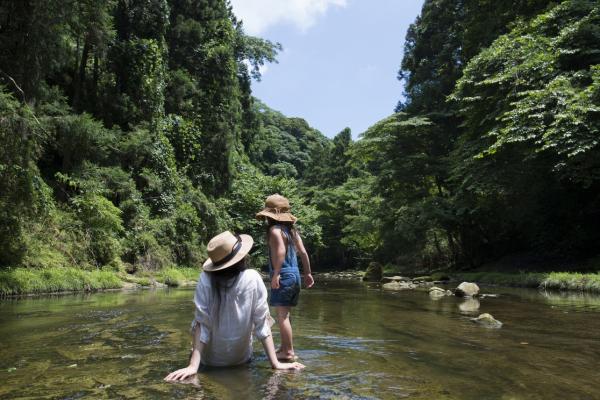
FPG researcher working to understand what types of green spaces are important for mental health
As many parents have experienced, young children often have a hard time managing their emotions after preschool pickup. Nissa Towe-Goodman, PhD, a research scientist at the UNC Frank Porter Graham Child Development Institute (FPG), learned this firsthand when her now 13-year-old daughter Addie was younger. As Towe-Goodman explained, young children frequently “use their good energy” at school and feel comfortable decompressing and being upset in the company of their parents.
To address this with Addie, Towe-Goodman regularly brought her to walk along and play by the Eno River after preschool. She noticed that Addie was almost instantaneously more grounded on those days and when they returned home, “things would be calm, cool and collected.”
Having studied emotional development in young children, Towe-Goodman was intrigued by this observation. After reading about research showing the incidence rate of diagnosable psychiatric disorders in adults was lower in those who grew up near green spaces as children, Towe-Goodman became interested in exploring how the availability of natural areas could offset the development of those disorders.
Her current research project, “Types of green spaces and the development of anxiety, depression, and ADHD in rural, low-income communities,” began on April 1 and runs for two years. This work recognizes that the mental health of children in the United States is a national emergency, with notable and accelerating rates of anxiety, depression, and ADHD.
Towe-Goodman understands that the benefits of green spaces may be even greater in low-income areas, buffering or mitigating the impact of physical and social stressors, and serving to reduce mental health disparities. Green spaces offer the potential for novel, community-level support to offset risk for anxiety, depression, and ADHD, yet evidence-based guidelines on the timing and types of exposures that are beneficial are unclear, as well as the benefits of green spaces for children outside of urban areas.
There is a paradox that rural, low-income communities have a lot of green space but poor mental health. Towe-Goodman is working to determine the factors that alter the relative impact of green spaces by addressing these gaps, establishing:
- the buffering role of green spaces in low-income, rural communities for anxiety, depression, and ADHD risk;
- whether the relative benefits of green spaces are consistent across childhood;
- whether different types of green spaces (general vegetation density, proximity to public parks or residential exposure to woodlands, grasslands, or croplands) convey similar benefits; and
- whether green spaces buffer children from poverty-related adversity in these communities.
Towe-Goodman is drawing from 18 years of observational, survey, and medical record data gathered from the Family Life Project, a population-based study of 1,292 children born in low-income, rural communities. The types of green spaces are available to children in poor rural areas are very different from urban areas, which is where most of the existing research has taken place.
“While there is potentially a lot of green space in rural areas, the quality is very different, which may have implications for how these aspects of nature offset mental health risk,” said Towe-Goodman.
“While there is potentially a lot of green space in rural areas, the quality is very different, which may have implications for how these aspects of nature offset mental health risk,” said Towe-Goodman. “In urban and suburban areas, if you have a park where you can meet up with friends or have a forest that you can play in, that is very different than if you live next to an industrial cornfield or a hog farm. I think it is likely that these do not have the same restorative potential as other types of green spaces.” Through this research, she hopes to understand the specific aspects that make green spaces restorative, and what specific types of natural environments are important for mental health.
Conghe Song, PhD, chair of Carolina’s Department of Geography and Environment, will guide the extraction of information about forests and agriculture areas from prior satellite imagery around the homes of children who participated in the Family Life Project, and the ways these areas have changed over the past 20 years. This will enable the project team to map what those environments were like when study participants were young and then track the trajectory of mental illness development over time into adulthood, to see if there are linkages.
Towe-Goodman hopes her project helps parents understand that nature can be a resource that helps children’s development, and the kinds of nature experiences that convey the most benefits. She notes that being out in nature can be important for the mental health of both parents and their children. Another project goal is to encourage policy makers to protect and promote natural environments that are important for mental health.
She and her daughter Addie continue their relationship with the outdoors. “We still go on walks in the woods and Addie still catches frogs in nearby streams,” said Towe-Goodman. “It remains something that we both really love.”
